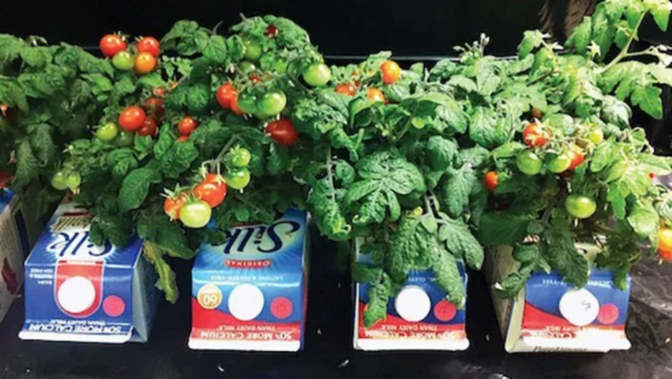By Staff Reports
(Hawaii)– With people sheltering in place and attempting to make fewer trips to the grocery store, the University of Hawaiʻi at Mānoa College of Tropical Agriculture and Human Resources (CTAHR) has launched a “How to Start Your Own Home Garden” series to help families stay healthy and engaged.
In the first installment, Department of Tropical Plant and Soil Sciences Associate Horticulturist Kent Kobayashi offers tips on micro-hydroponics. Micro-hydroponics allows people to grow miniature vegetable plants (less than 12 inches tall) hydroponically (without soil) in their house, apartment, garage or lanai. The simplest setup involves a container, seeds, growing medium, nutrients and light source.
Ways to use household items
Quart or half-gallon cardboard milk or juice cartons make excellent containers for growing mini vegetables. Make sure your cartons have a screw cap spout. This makes it easier to add nutrient solutions to the carton, which can be done with a funnel. Cut a hole in the carton large enough to support the cup that holds the growing medium. Make sure the hole is a little smaller than the rim of the cup, so it does not fall in.
As plants grow taller and their roots grow deeper, they need something to hold onto, also known as the growing medium. Foam cubes, like oasis cubes, provide an ideal growing medium to germinate vegetable seeds and grow plants. Alternative growing mediums include vermiculite, perlite, clay pellets, coconut fiber (coir) or pine wood shavings.
Small plastic pots like net pots are excellent for holding the growing medium inside milk cartons because they have vertical slits on the sides to allow the roots to grow through into the nutrient solution. An inexpensive alternative is small plastic cups with vertical slits cut into the sides.
Seeds

Vegetable seeds can start to grow directly in the growing medium and pots before they are inserted into the containers. Fill the cubes or the pots partway with the growing medium, place on a tray and plant 1–2 seeds in each one. If using cubes, insert the seeds into the hole in the cube. Add enough water to thoroughly moisten the medium and pour off any excess. Cover the tray with a clear plastic lid or tent it with plastic wrap. Make sure to leave enough space above the cups or cubes for the plants to sprout.
The UH Seed Laboratory continues to operate during the COVID-19 crisis. High-quality seeds for Hawaiʻi‘s unique growing conditions can be ordered by mail, email or phone, and delivered right to your door. Contact the UH Seed Lab at (808) 956-7890 or seed@ctahr.hawaii.edu. Also, check out local seeds offered by the Hawaiʻi Seed Growers Network, run by CTAHR’s GoFarm Hawaiʻi farm coach Jay Bost.
Nutrients and light
Any general-purpose, water-soluble fertilizer for vegetables will work. Each one has a different strength, so closely follow the manufacturer’s directions when mixing the nutrient solution.
Vegetables need a lot of light, so if you’re growing them indoors, they will do best with artificial lighting. The two best light sources are T5 high-output (HO) fluorescent lights and light-emitting diode (LED) lights.
As the vegetables grow, periodically add nutrient solution to the milk cartons with a funnel so the cartons remain about ¼ to ½ full. For more tips and how-to’s, visit Kobayashi’s micro-hydroponics website.
Support the UH Student Relief fund and COVID-19 research

